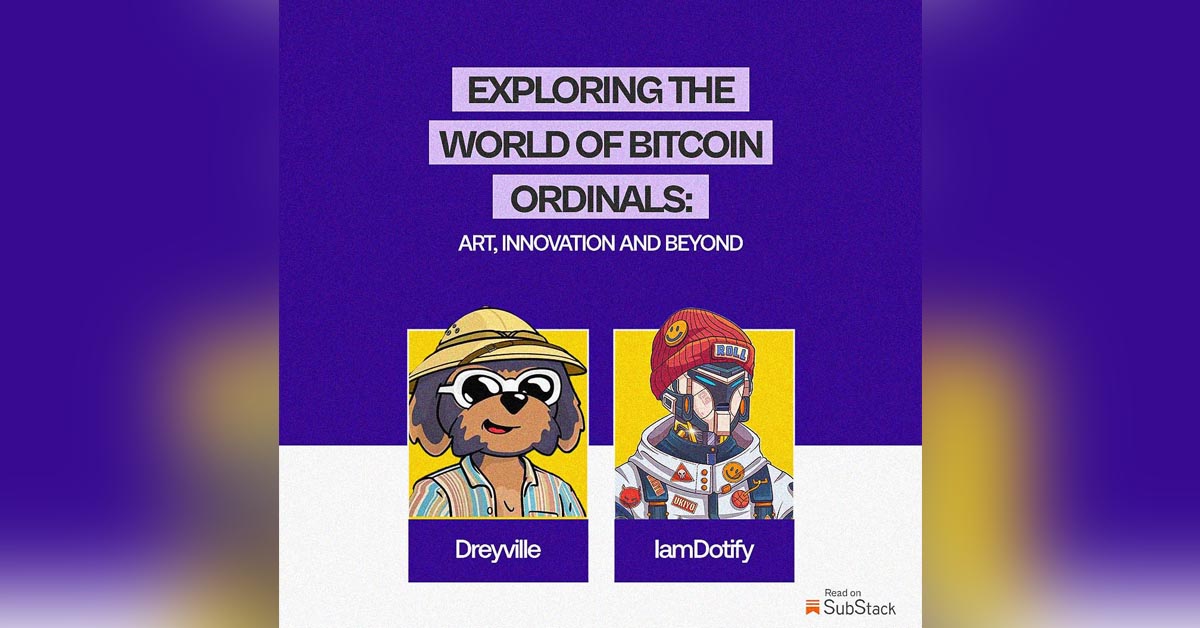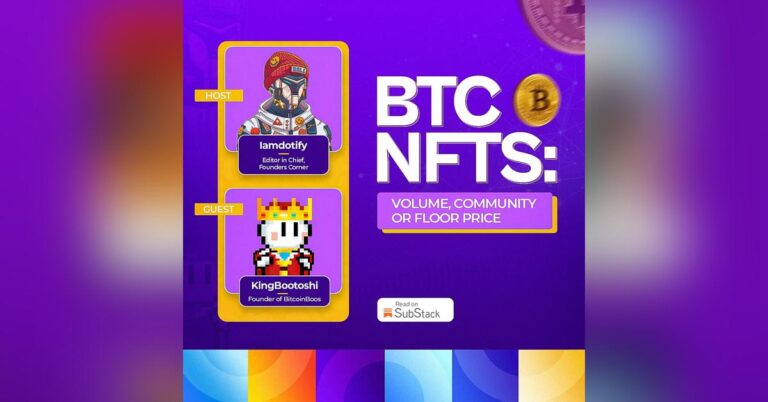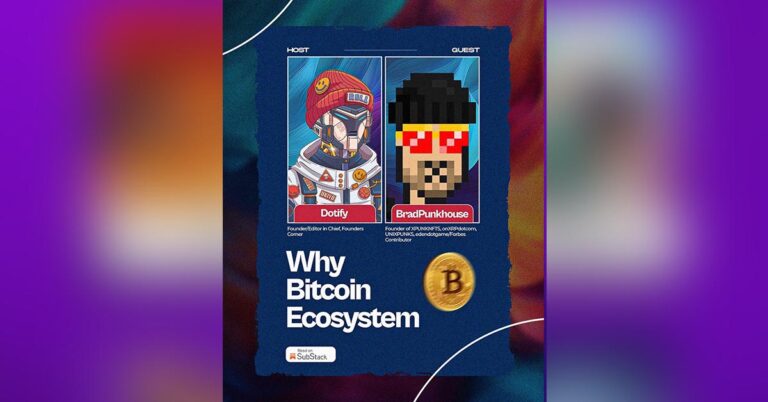Ordinals are a new and rapidly evolving addition to the world of Bitcoin. Imagine if every penny in your pocket had its own unique story/identity. That’s sort of what’s happening in the world of Bitcoin right now, with Ordinals.
In this article, we’ll explore the world of Ordinals in a way that’s easy for everyone to understand. We’ll explore how they work and what they mean for artists and creators, offering a whole new avenue of possibilities for digital art and innovation.
BITCOIN BASICS
Let’s start at the beginning. Bitcoin is like digital gold – a type of money that exists only online. Created by someone (or some people) under the pseudonym Satoshi Nakamoto in 2009, it was the first of what we now call cryptocurrencies. Just like you can break down a dollar into cents, Bitcoin can be broken down into smaller units called satoshis. One Bitcoin equals 100 million satoshis – think of satoshis as the pennies of Bitcoin.
WHAT ARE ORDINALS?
Now, let’s talk about Bitcoin Ordinals. Imagine if every penny you had was unique, with its own special number or mark that no one else had. That’s what Ordinals do for satoshis. They give each satoshi a unique identifier, turning it from just a tiny piece of Bitcoin into something special and one-of-a-kind.
INSCRIPTION PROCESS
So, how do you make a satoshi unique? Through something called an inscription. This is where things get creative. You can inscribe digital content like a picture, a piece of text, or even a tiny piece of code, right onto a satoshi. Once a satoshi has been inscribed, it carries this digital content with it on Bitcoin blockchain. It’s like turning a regular penny into a collector’s item with a unique artwork or message on it. Each inscribed satoshi becomes a unique and collectible piece of digital art or content.
HOW DO ORDINALS WORK?
Blockchain Technology: Think of the Bitcoin blockchain as a giant, super secure record book that’s shared across thousands of computers. Every transaction with Bitcoin is recorded in this ledger. When you inscribe something onto a satoshi, this unique information gets recorded on the blockchain too. Just like a library keeps track of which books are on which shelves, the Bitcoin blockchain keeps track of which satoshis have which inscriptions. It’s this system that makes sure everything is tracked and no one can copy or fake these inscribed satoshis.
Uniqueness: Each inscribed satoshi is completely unique, kind of like a digital snowflake. No two inscriptions are the same because they’re tied to a specific satoshi with a specific place on the blockchain. This uniqueness is a big deal because it means every inscribed satoshi can be a one-of-a-kind piece of art or digital content.
No Smart Contracts Needed: In other blockchain systems, like Ethereum, creating unique digital items often requires a smart contract – these are like automated programs that manage the NFTs. But with Bitcoin Ordinals, you don’t need these complex contracts. The Bitcoin blockchain takes care of everything, making it simpler and more direct to create and track these unique digital items.
On-Chain: Unlike many NFTs on other ecosystem, where the art itself is often stored off the blockchain, Ordinals are inscribed directly onto the Bitcoin blockchain. This means the art is not just linked but actually exists on the blockchain. This enhances the provenance, providing a clear and immutable history of the artwork’s creation and ownership, which is a big deal in the art world.
OPPORTUNITIES FOR ARTISTS AND FOUNDERS
Digital Art: For artists, Bitcoin Ordinals open up a whole new world of creativity. They can create digital art pieces that are inscribed directly onto individual satoshis. This means their artwork isn’t just a file on a computer; it’s part of the Bitcoin blockchain. It’s like having a painting that’s also a rare coin. Artists can sell these unique pieces, knowing that their art can’t be duplicated, thanks to the uniqueness of each inscribed satoshi.
Authenticity and Ownership: One of the coolest things about using the blockchain for art is how it handles authenticity and ownership. When an artist creates a piece of digital art on a satoshi, the blockchain keeps a permanent record of it. This works like a digital certificate of authenticity, proving that the art is the original. Plus, it tracks who owns it. So, if the art is sold, everyone can see the transfer of ownership, like a digital bill of sale.
Innovation Beyond Art: The potential of Ordinals stretches beyond just art. Think about gaming, where each in-game item could be unique and owned securely on the blockchain. Or imagine digital collectibles that can’t be faked, each with their own place in the Bitcoin world. The possibilities for innovation are vast and exciting, spanning various industries.
Community: The most important aspect of Ordinals is the community. This community is known for being welcoming and supportive, offering a space for artists, tech enthusiasts and collectors to collaborate, share ideas and help each other navigate this new frontier. Being part of the Ordinals community means being at the forefront of a digital revolution, with support and encouragement from like-minded individuals.
THE FUTURE OF BITCOIN ORDINALS
Potential Growth
The buzz around Bitcoin Ordinals is just getting started. More and more artists and tech enthusiasts are exploring this space, pushing the boundaries of what’s possible. We’re likely to see even more creative uses of Ordinals, not just in art but in other areas like gaming and digital collectibles. As more people catch on to this trend, we can expect a surge in innovation and new types of digital assets emerging on the Bitcoin blockchain.
Challenges
However, it’s not all smooth sailing. There are some challenges to consider:
Scalability: As more people start using Ordinals, the Bitcoin network needs to handle a lot of data. This could make things slower or more expensive if not managed properly.
Environmental Concerns: Bitcoin mining, the process of keeping the blockchain running, uses a lot of energy. Adding more transactions with Ordinals could increase this energy use, which is a concern for the environment.
Debate Within the Bitcoin Community: Not everyone in the Bitcoin world is on board with this idea. Some ‘laser eye maxis’ believe Bitcoin should stick to being a secure store of value, rather than branching into digital art and collectibles. They worry that these new uses could distract from or even weaken Bitcoin’s main purpose.
Closing Thoughts
Ordinals represent a fascinating new chapter in the digital world. They’re not just about creating unique digital items; they’re about reimagining what’s possible with Bitcoin. While there are challenges and debates, the potential for innovation and creativity is immense. Ordinals could very well be the beginning of a whole new era for digital content, ownership and art on the blockchain.
CONCLUSION
In this journey through the world of Bitcoin Ordinals, we’ve uncovered some exciting insights:
Bitcoin Ordinals transform ordinary satoshis into unique digital canvases for art and innovation.
Artists and Creators find a new medium in Ordinals, offering authenticity, ownership and a platform for unparalleled creativity.
Beyond Digital Art, the potential of Ordinals extends to gaming, collectibles and other digital realms, all underpinned by a supportive community. Despite the Potential Growth, challenges like scalability, environmental concerns, and differing opinions within the Bitcoin community remind us that this is uncharted territory.
As we stand at the edge of this new digital frontier, the possibilities with Bitcoin Ordinals seem as limitless as the blockchain itself. Whether you’re an artist, a tech enthusiast, or simply curious, there’s no better time to dive in and explore what Bitcoin Ordinals can offer. So why not start your own journey into this innovative world and see where it takes you?



